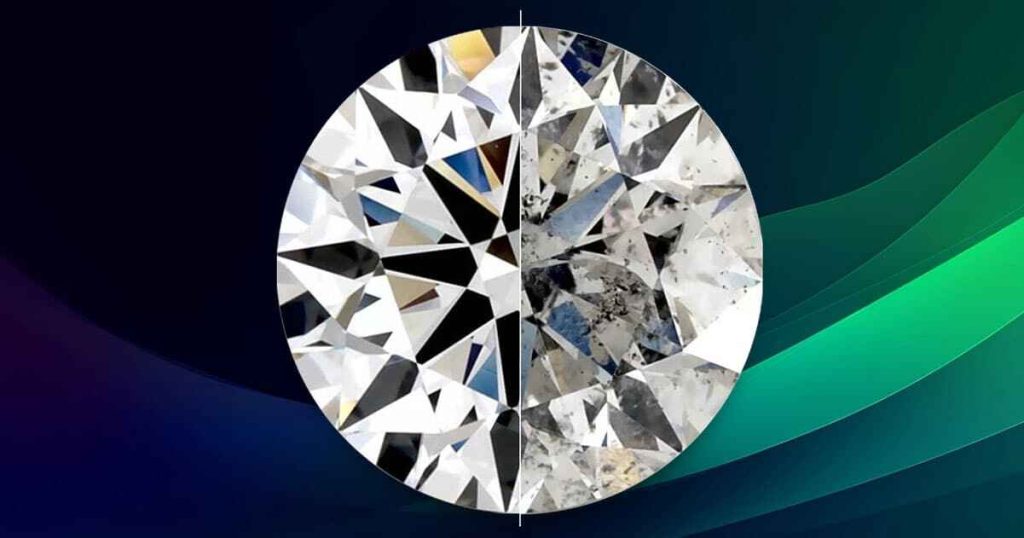Diamond clarity refers to the presence of internal and external flaws, or imperfections, in a diamond. These imperfections are called inclusions (internal flaws) and blemishes (external flaws).
Clarity is one of the four Cs of diamond grading, along with carat weight, color, and cut. The clarity grade of a diamond is determined by the number, size, type, and location of these flaws.
Table of Contents
Diamonds are graded for clarity using a scale established by the Gemological Institute of America (GIA), one of the most respected gemological laboratories. The GIA clarity scale includes the following grades, from best to least desirable:

international standard of diamond clarity
- Flawless (FL): No internal or external flaws visible under 10x magnification. Extremely rare and valuable.
- Internally Flawless (IF): No internal flaws visible under 10x magnification, but may have minor external flaws. Also very rare and valuable.
- Very, Very Slightly Included (VVS1 and VVS2): Minute inclusions that are difficult for a skilled grader to see under 10x magnification. VVS diamonds are of excellent quality and highly valuable.
- Very Slightly Included (VS1 and VS2): Minor inclusions that are visible under 10x magnification but are not easily visible to the naked eye. High-quality diamonds.
- Slightly Included (SI1 and SI2): Noticeable inclusions that are visible under 10x magnification and may be visible to the naked eye. Still considered good quality, especially if the inclusions are not visible without magnification.
- Included (I1, I2, and I3): Obvious inclusions visible to a skilled grader under 10x magnification and likely visible to the naked eye. Diamonds in this range are of lower quality and less valuable.
When choosing a diamond, it’s essential to strike a balance between clarity and other factors like cut, color, and carat weight, depending on your preferences and budget. Not all imperfections affect a diamond’s beauty or brilliance, so consulting with a reputable jeweler can help you find the best balance for your needs.
Chart 1: Scale of Diamond Clarity.
IF: No inclusions are visible to the trained eye under 10x magnification
VVS1: Minute inclusions extremely difficult to locate under 10x magnification
VVS2: Minute inclusions difficult to locate under 10 x magnification
VS1: Very small inclusions rather difficult to locate under 10x magnification
VS2: Very small inclusions rather easy to locate under 10x magnification
SI1: Small inclusions easy to locate under 10x magnification
SI2: Small inclusions obvious under 10x magnification, but invisible with the naked eye, from the crown side
P1: Large and/or numerous inclusions, visible with the naked eye, from the crown side
P2: Large and/or numerous inclusions, visible with the naked eye and decreasing the brilliance slightly
P3: Large and/or numerous inclusions, visible with the naked eye, from the crown side and decreasing the brilliance and durability.
*The clarity of a diamond has to be examined under normalized light, with an achromatic and aplanatic lens magnifying 10x, by a qualified grader.
Chart 2: Comparative chart of the principal Grading System.
| IGI | GIA | CIBJO |
| FL | FL | – |
| IF | IF | LOUPE CLEAN |
| VVS1 | VVS1 | VVS1 |
| VVS2 | VVS2 | VVS2 |
| VS1 | VS1 | VS1 |
| VS2 | VS2 | VS2 |
| SI1 | SI1 | SI1 |
| SI2 | SI2 | SI2 |
| P1 | I1 | P1 |
| P2 | I2 | P2 |
| P3 | I3 | P3 |
Gemological Institute of America – G.I.A.
International Diamond Council – I.D.C.
Confederation International de la Bijouterie, Joaillerie, Orfevrerie C.I.B.J.O
Remarks:
degree “Flawless” of G.I.A. describes a diamond, which has no internal and external faults. However, natural are accepted as long as they do not distort or thicken the girdle. Extra facets are tolerated when they are situated under the girdle and invisible through the crown.
if you want to know more about diamond clarity? , visit gia article about diamond clarity.
please visit our online diamond store



